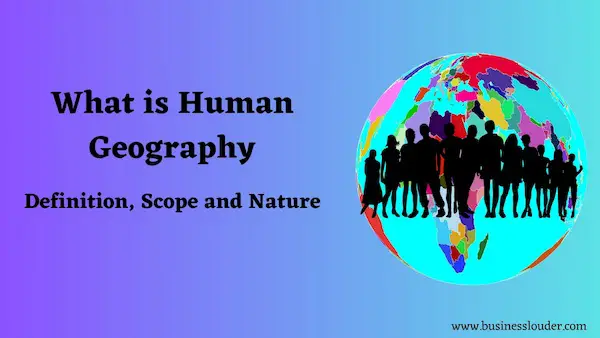Within the dynamic landscape of instructional interests, the field of human geography stands as an complex and multidimensional subject.

This article pursues to offer an broad and deeply unique understanding of what is human geography, including its definition, the significant scope it encompasses, and the fascinating nature that drives its look.
What is Human Geography?
Definition of Human Geography
What is human geography? Human geography is the systematic and methodical evaluation of the elaborate relationships that intertwine human societies and the environments in which they’re situated.
It seeks to understand and recognize the myriad methods wherein human sports, cultures, and societies intermingle with and shape the physical international that surrounds them.
In essence, human geography is the all-encompassing area that dives deep into information about the spatial dimensions of human lifestyles.
Scope of Human Geography
Human geography, with its wealthy tapestry of sub-disciplines, explores a huge and assorted array of subjects and areas of hobby.
It carefully examine the spatial distribution of populations, cultures, economies, and landscapes, setting particular emphasis on the dynamic and ever-evolving interaction between humans and the encircling environment.
These various field can be in addition segmented into specialized areas, every offering specific and insightful views into the multifaceted dating between humanity and the environment.
Sub-Disciplines of Human Geography
Cultural Geography: At the heart of cultural geography lies the look at diverse cultures, their diffusion, and the profound impact they exert on the landscapes and areas they inhabit.
It very well examines the impact of language, religion, customs, traditions, and social behaviors on spatial patterns, supplying a wealthy tapestry of human cultural variety.
Economic Geography: Economic geography dives deep into the distribution of assets, industries, and monetary sports throughout exceptional areas.
It meticulously investigates the mechanisms using exchange, globalization, and the complex dynamics of nearby development. In doing so, it unfolds the problematic styles that underlie the worldwide financial landscape.
Urban Geography: Urban geography directs its lens to the study of towns, the dynamics of their increase, and the multifaceted challenges they face.
It scrutinizes urbanization, transportation networks, land-use policies, and the problematic social cloth of cities, imparting beneficial insights into the complicated city landscape.
Political Geography: Political geography is an engaging sub-subject that delves deep into the effect of politics on the spatial agency of societies. It encompasses the examination of borders, geopolitics, strength systems, and the territorial dynamics that form the global political panorama.
This sub-discipline is instrumental in knowing how political forces mold the physical and cultural geography of regions.
Environmental Geography: Environmental geography is at the forefront of the war to unravel the elaborate and dynamic dating between people and the environment.
This sub-area covers an extensive variety of urgent environmental problems, which include weather change, aid management, sustainability, and the profound impact of human activities on the natural world. It’s miles an important field that informs guidelines and practices geared toward environmental upkeep and sustainability.
Population Geography: Population geography is dedicated to the in-intensity evaluation of the distribution and movement of human populations.
It scrutinizes factors including migration patterns, fertility quotes, mortality data, and demographics, offering a deep know-how of human mobility and populace dynamics. The sub-area additionally explores the position of population information in shaping public guidelines and resource allocation.
The Interdisciplinary Nature
One of the most fascinating components of human geography is its inherent interdisciplinary nature. This field attracts information and methodologies from a mess of other disciplines, inclusive of anthropology, sociology, economics, environmental science, history, and political technology.
This interdisciplinarity enriches the observation of human geography, fostering holistic information about the complicated interplay between human beings and their environment. As a result, human geography stays adaptable and relevant, ensuring its continued importance in an ever-converting international.
The Nature of Human Geography
Human geography is characterized by way of several one-of-a-kind attributes which are instrumental in the knowledge of its dynamic and ever-evolving nature:
Spatial Evaluation
In the pursuit of information in the sector, human geographers hire spatial analysis as a foundational device. This methodical technique allows for the introduction of maps, diagrams, and models that light up spatial patterns and procedures.
Spatial evaluation presents precious insights into the distribution of human sports and phenomena, from the clustering of cities to the spread of cultures. It is a critical issue of human geography, making sure that the field continuously unravels the intricacies of human-surroundings interactions.
Usage of Qualitative and Quantitative Methods
Researchers in human geography employ a combination of qualitative and quantitative study methods to color a complete image of the phenomena they observe. They behaviour surveys, interviews, and subject observations to collect qualitative records, including depth and context to their findings.
At the same time, they appoint statistical evaluation, mapping, and modelling to derive empirical, records-driven conclusions that offer treasured insights into complex geographical phenomena.
Addressing Social and Environmental Troubles
Human geography is frequently at the vanguard of addressing pressing social and environmental issues. Researchers in this area engage with complicated troubles which include weather trade, urbanization, migration, social inequalities, and political conflicts.
Via analyzing these challenges from a geographical perspective, human geography gives crucial insights that tell guidelines and moves for a sustainable, equitable, and just future. It plays a critical position in addressing the pressing challenges of our time and provides precious solutions to global issues.
The strength of Cartography and Visualization
Cartography, the art and science of mapmaking, is an effective tool within human geography. It serves as a way of visually representing complicated statistics and findings, helping in the effective communication of geographical insights.
A well-crafted map or visualization can inform a compelling tale, making it an essential thing of the area. The careful selection of symbols, colors, and scales allows human geographers to convey elaborate styles, traits, and relationships in an available and tasty way.
Conclusion
In summarize what is human geography, Human Geography is a dynamic, interdisciplinary, and versatile area to take a look at. By exploring its definition, the vast scope it encompasses, and the elaborate nature that defines its study, we have unveiled a subject that offers profound insights into the complicated dating between humanity and the environment.
As we navigate the demanding situations and opportunities of our ever-changing global, human geography remains a critical tool for understanding our beyond, gift, and destiny.
Also Read:


